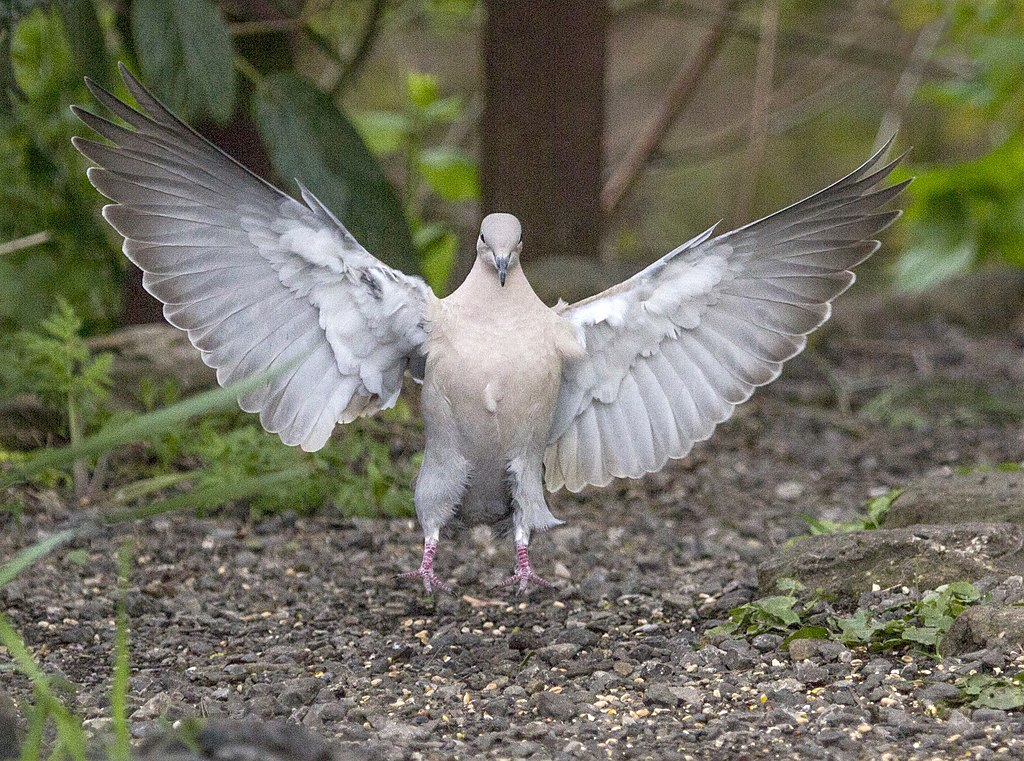Overall, the anatomy of Columbidae is characterized by short legs, short bills with a fleshy cere, and small heads on large, compact bodies. Like some other birds, the Columbidae have no gall bladders. Some medieval naturalists concluded they have no bile (gall), which in the medieval theory of the four humours explained the allegedly sweet disposition of doves. In fact, however, they do have bile (as Aristotle had earlier realized), which is secreted directly into the gut.
- Smith, Paul. “COLUMBIDAE Pigeons and Doves FAUNA PARAGUAY”. www.faunaparaguay.com.
- Hagey, LR; Schteingart, CD; Ton-Nu, HT; Hofmann, AF (1994). “Biliary bile acids of fruit pigeons and doves (Columbiformes)”. Journal of Lipid Research. 35 (11): 2041–8. doi:10.1016/S0022-2275(20)39950-8. PMID 7868982.
- “Doves”. The Medieval Bestiary. Retrieved 31 January 2010.
- Browne, Thomas (1646). Pseudodoxia Epidemica. Vol. III.iii (1672 ed.). available online at University of Chicago. Retrieved 31 January 2010.
Head bobbing
In a series of experiments in 1975 by Dr. Mark B. Friedman, using doves, their characteristic head bobbing was shown to be due to their natural desire to keep their vision constant. It was shown yet again in a 1978 experiment by Dr. Barrie J. Frost, in which pigeons were placed on treadmills; it was observed that they did not bob their heads, as their surroundings were constant.
- “Why do pigeons bob their heads when they walk? Everyday Mysteries: Fun Science Facts from the Library of Congress”. www.loc.gov.
- Necker, R (2007). “Head-bobbing of walking birds” (PDF). Journal of Comparative Physiology A. 193 (12): 1177–83. doi:10.1007/s00359-007-0281-3. PMID 17987297. S2CID 10803990.

Feathers
The wings are large, and have eleven primary feathers; pigeons have strong wing muscles (wing muscles comprise 31–44% of their body weight) and are among the strongest fliers of all birds.
- “Columbiformes (Pigeons, Doves, and Dodos) – Dictionary definition of Columbiformes (Pigeons, Doves, and Dodos)”. www.encyclopedia.com.
- Clairmont, Patsy (2014). Twirl: A Fresh Spin at Life. Harper Collins. ISBN 978-0-8499-2299-2.
Columbidae have unique body feathers, with the shaft being generally broad, strong, and flattened, tapering to a fine point, abruptly. In general, the aftershaft is absent; however, small ones on some tail and wing feathers may be present. Body feathers have very dense, fluffy bases, are attached loosely into the skin, and drop out easily. Possibly serving as a predator avoidance mechanism, large numbers of feathers fall out in the attacker’s mouth if the bird is snatched, facilitating the bird’s escape. The plumage of the family is variable.
- Schodde, Richard; Mason, I. J. (1997). Aves (Columbidae to Coraciidae). Csiro Publishing. ISBN 978-0-643-06037-1.
- Skutch, A. F. (1964). “Life Histories of Central American Pigeons” (PDF). Wilson Bulletin. 76 (3): 211.
- “DiversityofLife2012 – Pigeon”. diversityoflife2012.wikispaces.com.
- Hilty, Steven L. (2002). Birds of Venezuela. Princeton University Press. ISBN 978-1-4008-3409-9.
- “Columbiformes (Pigeons, Doves, and Dodos) – Dictionary definition of Columbiformes (Pigeons, Doves, and Dodos)”. www.encyclopedia.com.
Granivorous species tend to have dull plumage, with a few exceptions, whereas the frugivorous species have brightly coloured plumage. The Ptilinopus (fruit doves) are some of the brightest coloured pigeons, with the three endemic species of Fiji and the Indian Ocean Alectroenas being the brightest. Pigeons and doves may be sexually monochromatic or dichromatic. In addition to bright colours, pigeons may sport crests or other ornamentation.
- Valdez, Diego Javier; Benitez-Vieyra, Santiago Miguel (2016). “A Spectrophotometric Study of Plumage Color in the Eared Dove (Zenaida auriculata), the Most Abundant South American Columbiforme”. PLOS ONE. 11 (5): e0155501. Bibcode:2016PLoSO..1155501V. doi:10.1371/journal.pone.0155501. PMC 4877085. PMID 27213273.
- “Pigeon family Columbidae”. creagrus.home.montereybay.com.
- Baptista, L. F.; Trail, P. W.; Horblit, H. M. (1997). “Family Columbidae (Doves and Pigeons)”. In del Hoyo, J.; Elliott, A.; Sargatal, J. (eds.). Handbook of birds of the world. Vol. 4: Sandgrouse to Cuckoos. Barcelona: Lynx Edicions. ISBN 978-84-87334-22-1.
Flight

Columbidae are excellent fliers due to the lift provided by their large wings, which results in low wing loading;They are highly maneuverable in flight and have a low aspect ratio due to the width of their wings, allowing for quick flight launches and ability to escape from predators, but at a high energy cost.
- Alerstam, Thomas (1993). Bird Migration. Cambridge University Press. ISBN 978-0-521-44822-2.
- Forshaw, Joseph; Cooper, William (2015). Pigeons and Doves in Australia. Csiro Publishing. ISBN 978-1-4863-0405-9.
- Pap, Péter L.; Osváth, Gergely; Sándor, Krisztina; Vincze, Orsolya; Bărbos, Lőrinc; Marton, Attila; Nudds, Robert L.; Vágási, Csongor I. (2015). Williams, Tony (ed.). “Interspecific variation in the structural properties of flight feathers in birds indicates adaptation to flight requirements and habitat”. Functional Ecology. 29 (6): 746–757. doi:10.1111/1365-2435.12419.
Crop milk
Crop milk or pigeon milk produced by both male and female parent birds. Crop milk is a secretion from the lining of the crop of parent birds that is regurgitated to young birds. It is found among all pigeons and doves where it is referred to as pigeon milk. An analog to crop milk is also secreted from the esophagus of flamingos and the male emperor penguin.
- Levi, Wendell (1977). The Pigeon. Sumter, S.C.: Levi Publishing Co, Inc. ISBN 0-85390-013-2.
- Silver, Rae (1984). “Prolactin and Parenting in the Pigeon Family” (PDF). The Journal of Experimental Zoology. 232 (3): 617–625. doi:10.1002/jez.1402320330. PMID 6394702. Archived from the original (PDF) on 13 September 2016.
- Eraud, C.; Dorie, A.; Jacquet, A.; Faivre, B. (2008). “The crop milk: a potential new route for carotenoid-mediated parental effects” (PDF). Journal of Avian Biology. 39 (2): 247–251. doi:10.1111/j.0908-8857.2008.04053.x.
Crop milk bears little physical resemblance to mammalian milk. Crop milk is a semi-solid substance somewhat like pale yellow cottage cheese. It is extremely high in protein and fat, containing higher levels than cow or human milk. A 1939 study of pigeon crop milk showed, however, that the substance did not contain carbohydrates. It has also been shown to contain anti-oxidants and immune-enhancing factors which contribute to milk immunity. Like mammalian milk, crop milk contains IgA antibodies. It also contains some bacteria. Unlike mammalian milk, which is an emulsion, pigeon crop milk consists of a suspension of protein-rich and fat-rich cells that proliferate and detach from the lining of the crop. Lactation in birds is controlled by prolactin, which is the same hormone that causes lactation in mammals.
- Ehrlich, Paul R.; Dobkin, David S.; Wheye, Darryl (1988), “Bird Milk”, stanford.edu
- Davis, W.L. (1939). “The Composition of the Crop Milk of Pigeons”. Biochem. J. 33 (6): 898–901. doi:10.1042/bj0330898. PMC 1264463. PMID 16746989.
- Mysteries of pigeon milk explained, archived from the original on 2011-09-24
- Gillespie, M. J.; Stanley, D.; Chen, H.; Donald, J. A.; Nicholas, K. R.; Moore, R. J.; Crowley, T. M. (2012). Salmon, Henri (ed.). “Functional Similarities between Pigeon ‘Milk’ and Mammalian Milk: Induction of Immune Gene Expression and Modification of the Microbiota”. PLOS ONE. 7 (10): e48363. Bibcode:2012PLoSO…748363G. doi:10.1371/journal.pone.0048363. PMC 3482181. PMID 23110233.
- Gillespie, M. J.; Haring, V. R.; McColl, K. A.; Monaghan, P.; Donald, J. A.; Nicholas, K. R.; Moore, R. J.; Crowley, T. M. (2011). “Histological and global gene expression analysis of the ‘lactating’ pigeon crop”. BMC Genomics. 12: 452. doi:10.1186/1471-2164-12-452. PMC 3191541. PMID 21929790.
Pigeons
Pigeon’s milk begins to be produced a couple of days before the eggs are due to hatch. The parents may cease to eat at this point in order to be able to provide the squabs (baby pigeons and doves) with milk uncontaminated by seeds, which the very young squabs would be unable to digest. The baby squabs are fed on pure crop milk for the first week or so of life. After this the parents begin to introduce a proportion of adult food, softened by spending time in the moist conditions of the adult crop, into the mix fed to the squabs, until by the end of the second week they are being fed entirely on softened adult food.
Pigeons normally lay two eggs. If one egg fails to hatch, the surviving squab gets the advantage of a supply of crop milk sufficient for two squabs and grows at a significantly faster rate. Research suggests that a pair of breeding pigeons cannot produce enough crop milk to feed three squabs adequately, which explains why clutches are limited to two.
- Vandeputte-Poma, J.; van Grembergen, G. (1967). “L’evolution postembryonnaire du poids du pigeon domestique”. Zeitschrift für vergleichende Physiologie (in French). 54 (3): 423–425. doi:10.1007/BF00298228. S2CID 32408737.
- Blockstein, David E. (1989). “Crop milk and clutch size in mourning doves”. The Wilson Bulletin. 101 (1): 11–25. JSTOR 4162684.
The fact that none of the nearly 300 species of Columbiformes has a clutch size larger than two eggs suggests that there is limited plasticity in crop-milk production.
External links
Wikiquote has quotations related to Doves.
Wikimedia Commons has media related to Columbidae.
Wikispecies has information related to Columbidae.
Look up Columbidae in Wiktionary, the free dictionary.
- Columbidae.org.uk Conservation of pigeons and doves
- Dove videos on the Internet Bird Collection
- The differences between doves & pigeons
- Pigeon Fact Sheet from the National Pest Management Association with information on habits, habitat and health threats
- “Pigeon breeds: from the NPA Standard – Table of Contents by Groups”. NPAUSA.org. American National Pigeon Association. 2014.
- “British Pigeon Show Society Hall of Fame, Show Categories and Trophies”. Showpigeons. British Pigeon Show Society. 2014.
- “List of the Breeds of Fancy Pigeons” (PDF). Entente Européenne d’Áviculture et de Cuniculture. 1 October 2009.
- The Complete Guide To Pigeons (Columbidae)
- Article on Bird Milk from stanford.edu
- Article on the relationship between crop milk and clutch size in Mourning Doves (.pdf)
- Smithsonian National Zoo article on Common Crowned Pigeon, includes paragraph on crop milk
- Blechman, Andrew, Pigeons: The Fascinating Saga of the World’s Most Revered and Reviled Bird (Grove Press 2007) ISBN 978-0-8021-4328-0
- Gibbs, Barnes and Cox, Pigeons and Doves (Pica Press 2001) ISBN 1-873403-60-7


Leave a Reply